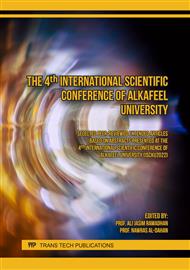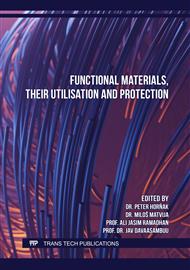[1]
British Standard Specification B.S 2975,1958 sand for making colorless glasses.
Google Scholar
[2]
Zullehner, W., Ullmann's Encyclopedia of Industrial Chemistry, Chaps. (1 – 4), Silicon. Wiley-VCH Verlag GmbH & Co. KGaA, Weinheim, 2005.
Google Scholar
[3]
Anna B., Krzysztof G., and Katarzyna G., The Resource Base of Silica Glass Sand versus Glass Industry Development: The Case of Poland, Resources, 9, 0134, 2020. doi:10.3390/resources9110134, www.mdpi.com/journal/resources.
DOI: 10.3390/resources9110134
Google Scholar
[4]
S. Anas Boussaa, A. Kheloufi, N. Boutarek Zaourar, F. Kerkar, Acta Phys. Pol. A 129, 133, 2016.
DOI: 10.12693/aphyspola.130.133
Google Scholar
[5]
Farmer A.D., Collings A.F., Jameson G.J., The application of power ultrasound to the surface cleaning of silica and heavy mineral sands, Ultrasonics Sonochemistry, 7, 243-247, 2000.
DOI: 10.1016/s1350-4177(00)00057-2
Google Scholar
[6]
Ngabea, S.A, Jijingi, H. E and Kwino, D. I., Development of a Rot-Oscillatory Particle Size Analysis Device, American Journal of Engineering Research (AJER), Volume-8, Issue-5, pp-378-385, 2019.
Google Scholar
[7]
J. Michael, Civil Engineering Dedan Kimathi, University of Technology, 2017.
Google Scholar
[8]
J. Herman, K. Zacnyl, R. Morris, K. Davis, Development of Crushing and Sieving Technologies for use in Sample Preparation in Mars Exploration, LLC 460 W. 34th St. New York, NY 10001, NASA Johnson Space Center, Houston, TX 77058, 2006.
Google Scholar
[9]
Abdullah, Waleed R. "Standard Sand Specifications Development by Mechanical Attrition Scrubbing to Make It Convenient for Cement Industry", Key Engineering Materials, Vol. 870, pp.61-70, 2020.
DOI: 10.4028/www.scientific.net/kem.870.61
Google Scholar
[10]
Al-Maghrabi M.N.H., Improvement of low-grade silica sand deposits in Jeddah area, Engineering Science, Vol.15, No.2, 113-128, 2004.
DOI: 10.4197/eng.15-2.8
Google Scholar
[11]
Zhang Z., Li J., Li X., Huang H., Zhou L., Xiong T., High-efficiency iron removal from quartz sand using phosphoric acid, International Journal of Mineral Processing, Vol. 114, No. 117, 30-34, 2012.
DOI: 10.1016/j.minpro.2012.09.001
Google Scholar
[12]
Tuncuk A., Akcil A., Removal of iron from quartz ore using different acids: a laboratory-scale reactor study, Mineral Processing & Extractive Metall. Rev, Vol. 35, No. 4, 217-228, 2014.
DOI: 10.1080/08827508.2013.825614
Google Scholar
[13]
Styriakova I., Mockovciakova A., Styriak I., Kraus I., Uhlik P., Madejova J., Orolinova Z., Bioleaching of clays and iron oxide coatings from quartz sands, Applied Clay Science, 61, 1-7, 2012.
DOI: 10.1016/j.clay.2012.02.020
Google Scholar
[14]
Ibrahim S.S., Selim A.Q., Hagrass A.A., Gravity Separation of Silica Sands for Value Addition, Particulate Science and Technology, 31, 590–595, 2013.
DOI: 10.1080/02726351.2013.800930
Google Scholar
[15]
Hacifazlioglu H., Enrichment of silica sand ore by cyclojet flotation cell, Separation Science and Technology, 49, 1623-1632, 2014.
DOI: 10.1080/01496395.2014.893357
Google Scholar
[16]
Kazutoshi, H., Moses, C., Siame, A., Removal of Silica and Alumina as Impurities from Low-Grade Iron Ore Using Wet High-Intensity Magnetic Separation and Reverse Flotation, Journal of Minerals and Materials Characterization and Engineering, Vol.6 No.3, 2018, https://doi.org/10.4236/ jmmce.2018.63027
DOI: 10.4236/jmmce.2018.63027
Google Scholar
[17]
Rachappa, S. and Prakash, Y. Iron Ore Recovery from Low Grade by Using Advance Methods. Procedia Earth and Planetary Science, 11, 195-197, 2015. https://doi.org/10.1016/j.proeps. 2015.06.024
DOI: 10.1016/j.proeps.2015.06.024
Google Scholar
[18]
Araujo, A., Viana, P. and Peres, C. Reagents in Iron Ore Flotation. Minerals Engineering, 18, 219-224, 2005
DOI: 10.1016/j.mineng.2004.08.023
Google Scholar
[19]
A. Tuncuk, S. Ciftlik, A. Akcil, Hydrometallurgy 134–135, 80, 2013.
Google Scholar
[20]
Daykh, B. A., Mahdi, S. N., Purification of silica sand for the manufacture of scientific glass. General Company for Geological Survey and Mining, report number 2888, 2005.
Google Scholar
[21]
Cyanamid, mining chemical handbook, Mineral Dressing Notes 26.1, P. 67–68, Published by American Cyanamid Company, 1989.
Google Scholar
[22]
Abdel-Malik, D., A., Study of the concentration of sand from Ardhumah silica for traditional glass industries. Master's thesis, unpublished, University of Technology, Baghdad, 1998.
Google Scholar
[23]
Jajjoo, R., y., Al-Dojaili, Y., Beneficiation of Iraqi silica sand from Ardhumah Area, GEOSURV, inter.rep.no. 883, 1977.
Google Scholar



